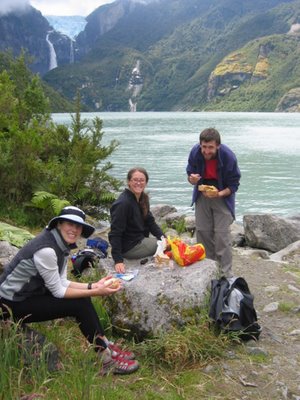Torres del Paine National Park is considered by many to be the premier national park in Chile, perhaps in South America. Surprisingly, many North Americans are not aware of its existence. On telling folks we planned to travel in South America, our conversations frequently proceeded as follows:
"Oh, lovely! Be sure to visit Machu Picchu. It´s fantastic!"
"Uh, well, we hadn´t planned to go there..."
"Oh, well, then you must be going to the Galapagos..."
"Um, actually, we probably won´t quite make it there, either. It´s a pretty expensive place to visit."
"Oh.... Um.... Well, um, where are you going?"
"Well, our real goal is to hike Torres del Paine."
"Torres del what? What´s that???"
 Despite this long-contemplated goal, I´m not sure I could tell you what TDP actually is, aside from a small range of spectacular glaciated mountains that can be circumnavigated in a 100-120 km. hike. National Geographic said they´re one of the world´s most spectacular wilderness areas. That and a few photos and trip accounts we reviewed on line were good enough for us.
Despite this long-contemplated goal, I´m not sure I could tell you what TDP actually is, aside from a small range of spectacular glaciated mountains that can be circumnavigated in a 100-120 km. hike. National Geographic said they´re one of the world´s most spectacular wilderness areas. That and a few photos and trip accounts we reviewed on line were good enough for us.
Instead of taking the 2 hour bus ride into the park from the nearest town, we elected for the all-day boat ride in. This began on a tour boat, visiting glaciers in nearby Bernardo O´Higgins Nat´l Park. After lunch at an "estancia" (ranch) now converted to hosting anglers and other tourist visitors, we continued by Zodiac up a glacier-fed river to a falls, hiked around the falls, and took a second Zodiac further up river into the park, tranferring to a van for the last few km to the park administration center. This was certainly less efficient than the bus ride from town to the same destination, but far more scenic.
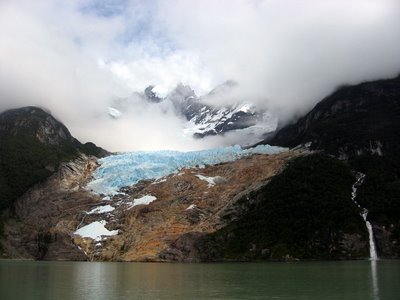
Receding glacier in Bernardo O´Higgins NP. (BOH commanded the forces that won Chile´s independance from Spain in the 1817. He was also Chile´s first dictator. [How was it that George didn´t become dictator of the newly independent colonies?] Every city, town, village, and hamlet here seems to have a street named after him.)
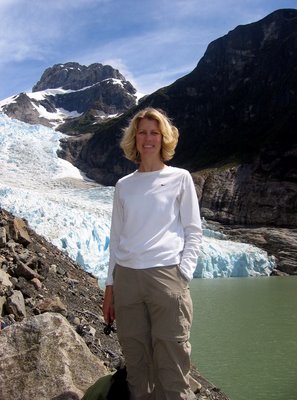
And another glacier. (Get used to seeing pictures of these. They were everywhere, and we couldn´t seem to stop taking photos of them.)
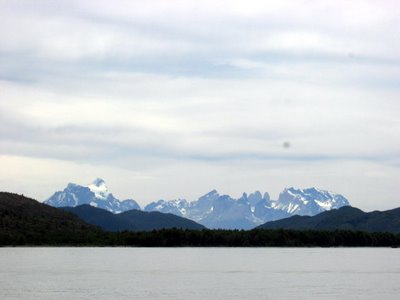
As our boat neared the park, we were treated to vistas of the mountain range in which we would spend our next several days. They are divided into the Paine Massif on the left, the Cuernos (Horns) roughly middle right, and a distant view of the actual Torres (towers) behind these.
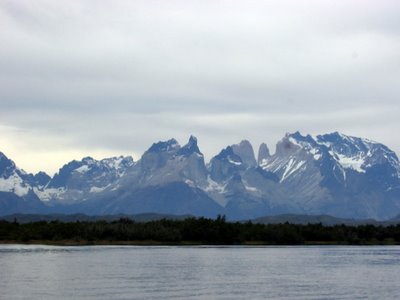 Closer view of the Cuernos and a Torre or two.
Closer view of the Cuernos and a Torre or two.
 Finally, at about 5 p.m., we loaded up or packs and headed out on the trail into the long summer evening.
Finally, at about 5 p.m., we loaded up or packs and headed out on the trail into the long summer evening.
 Skiing with Jolene's dad, Ivan Bauer, at Tahoe. Jolene wanted to take her ski equipment, so I packed my stuff, too. And a good thing it was! We had about the best day of skiing I can remember -- midweek lift lines, great weather, great snow, and great company!
Skiing with Jolene's dad, Ivan Bauer, at Tahoe. Jolene wanted to take her ski equipment, so I packed my stuff, too. And a good thing it was! We had about the best day of skiing I can remember -- midweek lift lines, great weather, great snow, and great company! Being in the neighborhood, we dropped in on the annual "Egg Drop" contest at my alma mater, Walla Walla College. The "Egg Drop", sponsored by the ASME (American Society of Mechanical Engineers), is one way of drawing the public into the challenges of engineering design. The contest is open to all, with the simple goal of conveying a raw egg from a height to the ground, by force of gravity, without breakage. Prizes are awarded in various categories such as "Closest to Target", "Lightest Packaging", and (my favorite) "Most Heartbreaking Failure".
Being in the neighborhood, we dropped in on the annual "Egg Drop" contest at my alma mater, Walla Walla College. The "Egg Drop", sponsored by the ASME (American Society of Mechanical Engineers), is one way of drawing the public into the challenges of engineering design. The contest is open to all, with the simple goal of conveying a raw egg from a height to the ground, by force of gravity, without breakage. Prizes are awarded in various categories such as "Closest to Target", "Lightest Packaging", and (my favorite) "Most Heartbreaking Failure". OK, just so we're clear: Jolene was not serving as the target for the egg drop. (It was snowing, and she was just thirsty.)
OK, just so we're clear: Jolene was not serving as the target for the egg drop. (It was snowing, and she was just thirsty.) Entrants for the egg drop weigh in their creations. Note the sophisticated structural materials in the foreground.
Entrants for the egg drop weigh in their creations. Note the sophisticated structural materials in the foreground. The Egg Drop's answer to Vanna White inspects one recently arrived "package"...
The Egg Drop's answer to Vanna White inspects one recently arrived "package"... ... and recovers the contained egg, proving (as I recall in this case) that the egg survived. (Note the frying pan marking the center of the target area.)
... and recovers the contained egg, proving (as I recall in this case) that the egg survived. (Note the frying pan marking the center of the target area.)










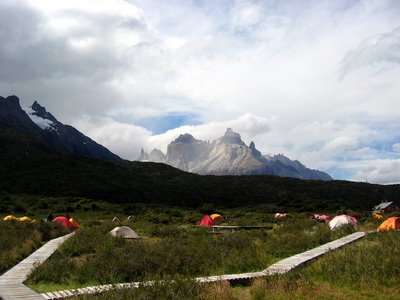
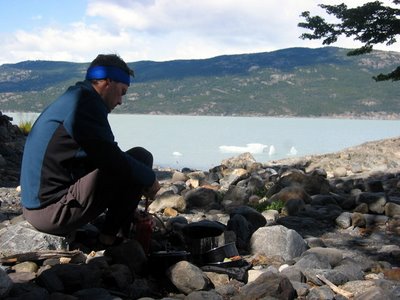








 We found these berries carpeting the ground in several areas of the park. We hear that, if you eat them, you are sure to return to Patagonia. We only ate jam made from them. So does that me we´ll jam in another trip sometime???
We found these berries carpeting the ground in several areas of the park. We hear that, if you eat them, you are sure to return to Patagonia. We only ate jam made from them. So does that me we´ll jam in another trip sometime???




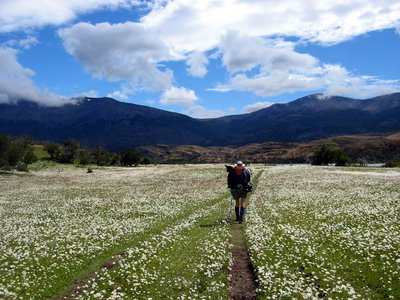
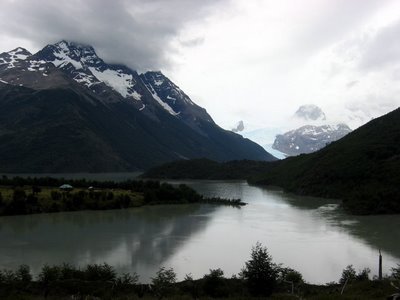
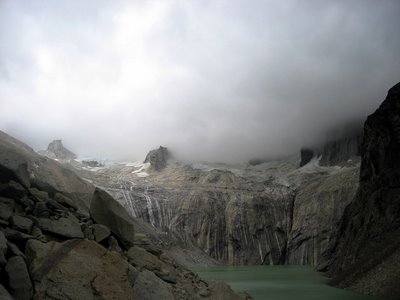



 Despite this long-contemplated goal, I´m not sure I could tell you what TDP actually is, aside from a small range of spectacular glaciated mountains that can be circumnavigated in a 100-120 km. hike. National Geographic said they´re one of the world´s most spectacular wilderness areas. That and a few photos and trip accounts we reviewed on line were good enough for us.
Despite this long-contemplated goal, I´m not sure I could tell you what TDP actually is, aside from a small range of spectacular glaciated mountains that can be circumnavigated in a 100-120 km. hike. National Geographic said they´re one of the world´s most spectacular wilderness areas. That and a few photos and trip accounts we reviewed on line were good enough for us.



 Finally, at about 5 p.m., we loaded up or packs and headed out on the trail into the long summer evening.
Finally, at about 5 p.m., we loaded up or packs and headed out on the trail into the long summer evening.





